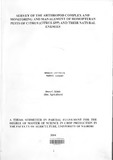| dc.description.abstract | Citrus production in Kenya is hindered by several constraints. These include pests and
diseases, inadequate disease-free planting materials, drought, low soil fertility and poor
orchard management in order of decreasing importance. This study was undertaken to
determine important pests of citrus and their natural enemies, to monitor the seasonal
fluctuations of major homopteran pests and to evaluate the efficacy of various pesticides
on homopteran pests in the farmers’ fields.
To determine important pests of citrus, a survey was conducted using a structured
questionnaire administered to 63 citrus farmers drawn from three major agro-ecological
zones present within Bungoma and Machakos districts. This was followed by an on-spot
assessment of insect species on randomly selected citrus trees in each farm. To monitor
the seasonal population fluctuations, four randomly selected farms in two locations,
Upper midlands (UM) and Lower midlands (LM) zones were used. In each farm, four
citrus trees were marked for monitoring homopteran pests and the natural enemies
fortnightly for two seasons. In the same zones, three orchards were used to evaluate the
efficacy of selected pesticides on the homopteran pests. Pesticides used included
Metasystox (Oxydementon methyl), Confidor (Imidacloprid), DC Tron (petroleum spray
oil) and a mixture of Metasystox and DC Tron. These were applied as foliar or soil
drench and in two regimes fortnightly or monthly applications. Homopteran pests were
counted fortnightly in the experiment.
A hundred and seventeen insects species were found associated with the citrus plants.
Eighty-seven of them were pests while 30 were their natural enemies. The most
important pest species were citrus whiteflies, citrus psyllids, aphids, blackflies, scale
insects, leafhoppers, and leaf miner. All were widely distributed in the three agroecological
zones. The natural enemy complex comprised of the spiders, coccinellids,
chrysopids, mantids, tachnids, syrphids and reduviid bugs. However, important and
conspicuous natural enemies were the spiders and the coccinellids. Farmers relied on
their own knowledge to make pest management decisions; hence the pest control
strategies applied were inadequate. Monitoring showed that homopteran pest populations
varied with seasons and location. Whitefly, aphid and citrus psyllid populations
significantly fluctuated with seasons (P<0.05) whereas aphid, blackfly and citrus psyllid
populations significantly varied with location (P<0.05). The insect pest load was
heaviest during the vigorous flush growth periods, which were preceded by rainfall and
the loads were light during the hot and dry months. Treatment schedules significantly
reduced the pest populations and the natural enemies (P<0.001). Metasystox schedules
had the least populations, particularly in the UM zone. Their effect was, however, not
different from Confidor and DC Tron schedules, which effectively lowered homopteran
pest populations. Soil drench and foliar methods of applications did not differ nor did the
fortnightly and monthly regimes of applications in their effect on homopteran pests.
The findings have shown that citrus are associated with many insect species. Some of the
pests observed are known vectors of diseases pointing to the need for effective pest
management to prevent the spread of diseases. The rich diversity of natural enemies
dominated by the spiders and coccinellids indicates that the pests are under some form of
natural control. Natural enemies require conservation to play a significant role in
suppressing pest populations. Flush growth identified as the critical period for protection
of citrus should be the target of any pest control strategy to prevent increases of pest
populations. Pesticides demonstrated to effectively reduce pest populations in the
farmer’s fields could be used as a component of an Integrated Pest Management (IPM)
strategy of citrus pests. Monthly schedules of Confidor or DC Tron as soil drench and
foliar applications, respectively, would help optimise the use of synthetic pesticides
while conserving natural enemies. An IPM strategy utilizing scouting and judicious use
of insecticides among other components would help citrus farmers to deal effectively
with insect pest problems in their orchards. Farmers need training on insect pest and
natural enemy identification as well as effective use of pesticides to help bridge the
knowledge gap identified in crop protection practices among them. | en |

